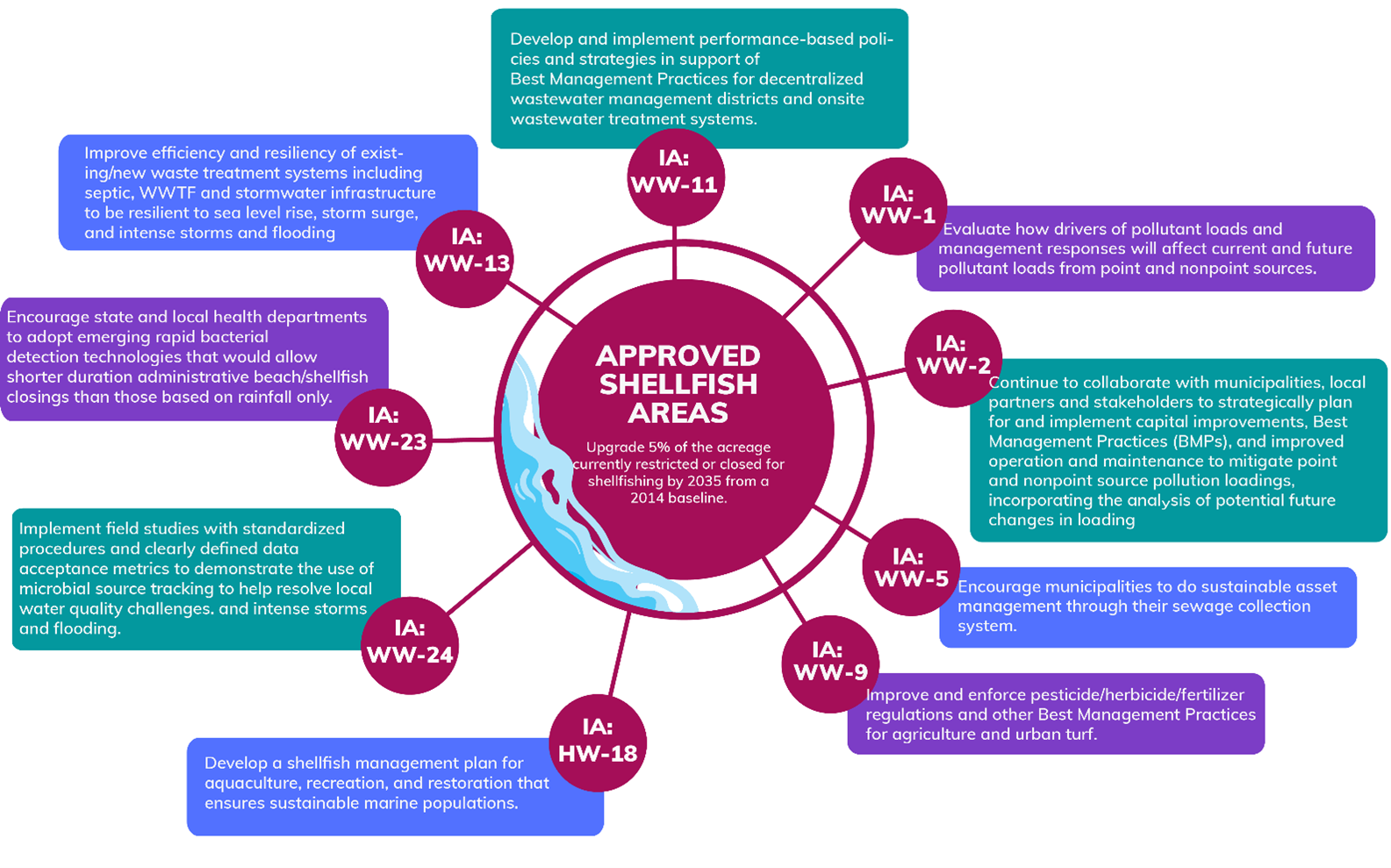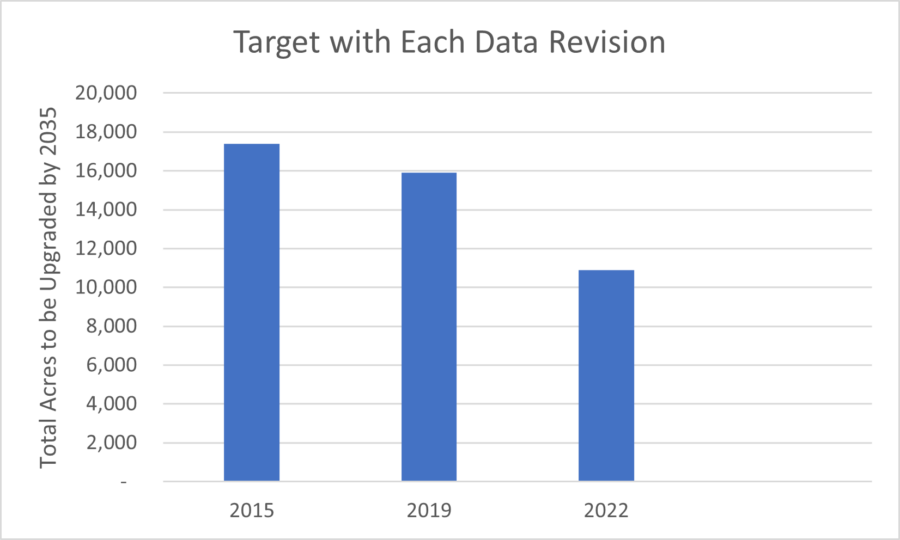Ecosystem Targets and Supporting Indicators
Approved Shellfish Areas
Upgrade 5% of the acreage currently restricted or closed for shellfishing by 2035 from a 2014 baseline.
View Implementation Actions for Approved Shellfish AreasProgress
| Approved Shellfish Acreage (CT) 2006-2024 | ||||||||
|---|---|---|---|---|---|---|---|---|
| CT Closed (Acres) | CT Conditionally Approved (Acres) | CT Approved (Acres) | NY Closed (Acres) | NY Certified - Approved (Acres) | NY Seasonally Approved (Acres) | Total | % Closed | |
| 2006 | 162,006 | 93,048 | 138,678 | 53,254 | 376,550 | 1,612 | 821,340 | 26.2% |
| 2007 | 162,121 | 93,764 | 138,784 | 53,251 | 376,553 | 1,612 | 821,340 | 26.2% |
| 2008 | 161,443 | 93,764 | 138,735 | 53,299 | 376,505 | 1,612 | 820,662 | 26.2% |
| 2009 | 161,827 | 93,836 | 138,873 | null | null | null | null | null |
| 2010 | 161,904 | 92,818 | 138,833 | 53,300 | 376,504 | 1,612 | 820,662 | 26.2% |
| 2011 | 161,915 | 99,156 | 138,573 | 50,564 | 379,355 | 1,497 | 820,662 | 25.9% |
| 2012 | 162,233 | 99,132 | 138,849 | 50,639 | 379,329 | 1,448 | 820,665 | 25.9% |
| 2013 | 161,700 | 101,131 | 138,480 | 50,639 | 379,329 | 1,448 | 820,663 | 25.9% |
| 2014 (Baseline Year) | 167,264 | 95,567 | 141,503 | 50,610 | 378,967 | 1,839 | 820,663 | 26.5% |
| 2015 | 167,233 | 95,598 | 141,611 | 50,245 | 379,032 | 2,138 | 820,663 | 26.5% |
| 2016 | 164,889 | 97,954 | 138,841 | 50,245 | 379,032 | 2,138 | 820,650 | 26.2% |
| 2017 | 164,796 | 98,060 | 99,146 | 50,245 | 379,032 | 2,138 | 820,663 | 26.2% |
| 2018 | 165,528 | 98,006 | 99,200 | 50,028 | 379,249 | 2,139 | 821,341 | 26.2% |
| 2019 | 164,189 | 77,391 | 97,475 | 50,627 | 384,969 | 2,083 | 827,604 | 26.0% |
| 2020 | 164,524 | 78,163 | 97,808 | 51,974 | 383,409 | 2,295 | 827,604 | 26.2% |
| 2021 | 164,524 | 78,163 | 97,808 | 47,221 | 386,044 | 2,486 | 825,675 | 25.6% |
| 2022 | 164,420 | 78,529 | 97,634 | 46,740 | 382,222 | 2,583 | 821,470 | 25.7% |
| 2023 | 159,565 | 78,434 | 151,934 | 46,931 | 383,848 | 3,531 | 823,293 | 25.1% |
| 2024 | 159,622 | 78,430 | 151,880 | 47,867 | 384,017 | 2,648 | 823,513 | 25.2% |
| Progress to Target | ||
|---|---|---|
| Year | Closed Acres Upgraded Compared to Baseline | % Reduction in Total Closed Acres Compared to Baseline |
| 2015 | 395 | 0.2 |
| 2016 | 2,739 | 1.3 |
| 2017 | 2,832 | 1.3 |
| 2018 | 2,318 | 1.1 |
| 2019 | 3,058 | 1.4 |
| 2020 | 1,376 | 0.6 |
| 2021 | 6,129 | 2.8 |
| 2022 | 6,714 | 3.1 |
| 2023 | 10,425 | 4.8 |
| 2024 | 10,385 | 4.8 |
Status and Trends
In order to meet the 2035 target, Connecticut and New York would need a 5 % reduction in closed acres, this is approximately 519 of the acres upgraded each year. As of 2024, Connecticut and New York have reduced the total number of closed acres by 4.8%, equating approximately to a total of 10,385 acres. While this improvement is enough to consider this on track, there is still much improvement needed by 2035 and gains that have been achieved are not necessarily permanent gains.
Shellfish area upgrades refer to the conversion of closure areas into seasonally approved, certified, conditionally approved, or approved areas. Closure areas for shellfish have different classifications determined through annual field inspections. In New York, closures are classified as certified, seasonal, or uncertified. In Connecticut, closures are classified as relay restricted, conditionally restricted, or prohibited. Regulatory and prohibited closures may occur when an area is too close to a known pollution source or when monitoring is unavailable to determine its safety. Seasonal closures can result from natural pathogen outbreaks or harmful algal blooms, as well as man-made pollution like sewage. Previous closures in Long Island Sound were caused by Vibrio parahaemolyticus, a naturally occurring marine bacterium unrelated to sewage or pollution, with the most recent occurrences in 2012 and 2013. New York has implemented a Vibrio Control Plan in 2023 to address this issue. For more information on shellfish classifications and closure notifications in New York, visit the state’s Shellfishing website and sign up for DEC Delivers updates. To find out more about Connecticut’s shell fishing classifications and be informed of closure notifications see Connecticut’s Shellfishing website (temporary closures in Connecticut are communicated from local entity that manages the temporary closure activity).
Challenges
As shellfish harvests are most often directly consumed by the public a vigorous monitoring, inspection and management program is essential to ensure public safety. Monitoring is costly and resource intensive; these needs can exceed each State’s and Municipalities capacity.
Furthermore, a significant rain event can result in an increase of pollution to a shellfish bed and may need to be closed until monitoring can be completed or enough time has passed to assure public safety. As rain events increase in intensity and frequency this may pose an additional stressor on monitoring needs and the Long Island Sound’s ability to meet this target.
This weather variability, among other factors, add a complexity to tracking progress. Gains in one particular year are not necessarily permanent gains. Therefore, success of this ecosystem target is evaluated with caution and a conservative approach.
How is This Target Measured?
The New York State Department of Environmental Conservation (NYSDEC) and the Connecticut Department of Agriculture (CTDOAG) Aquaculture Division regularly monitors shellfish areas for improvements or degradation of water quality and status of pollution sources, and to determine whether its classification for harvesting species should be upgraded or downgraded.
How is this target addressed?
Each Ecosystem Target is supported through the tangible strategies known as Implementation Actions (IA) that are identified in the Long Island Sound’s Comprehensive Conservation and Management Plan (CCMP). While each of these IAs identified below lead to water quality and management improvements that will enable more upgrades to shellfishing areas, many are indirect support. Such as WW-23, these laboratory methods while helpful for identifying the root of the cause, are not methods approved by the Food and Drug Administration to reclass the areas.

Importance
Shellfish beds are regularly monitored to assure that shellfish harvested in commercially and recreationally approved areas are safe to eat.
A variety of shellfish are commercially and recreationally harvested each year from Long Island Sound for human consumption. Each year in Connecticut alone approximately 10,000 citizens procure permits to harvest shellfish. In 2015 recreational shellfishing had an overall impact of 1.6 million dollars on Connecticut’s economy. In 1999, the shellfishing industry was estimated to contribute over 11o million dollars to New York’s economy.
Contact
Samarra Scantlebury, NYS Department of Environmental Conservation
Samarra.Scantlebury@dec.ny.gov
Kathleen Knight, CT Department of Energy and Environmental Protection
Kathleen.Knight@ct.gov
Alissa Dragan, CT Department of Agriculture Bureau of Aquaculture
Alissa.Dragan@ct.gov
Source of Data
NYSDEC and CTDOAG
CT Seagrant, 2021, Catching Value, an Assessment of Connecticut’s Recreation Shellfish Sector.
NY Seagrant, 2001, The Economic Contribution of Sport Fishing, Commercial Fishing and Seafood Industries to New York State.
DATA NOTES
The technical explanation on how the target was originally selected is found in Appendix B of the Comprehensive Conservation and Management Plan. Modifications to this method to account for the latest science and methods are noted below.
- The NY acreage data was updated to represent the implementation of more precise measuring techniques in early 2019 and again in 2022 to capture the impact of sea level rise and coastal erosion.
- In 2017 the Connecticut Department of Agriculture, Bureau of Aquaculture underwent a major reclassification effort. This effort was combined with the enhanced information to further delineated temporary closures. Delineations were made to classify areas whereby:
- the factors influencing the area do not preclude a management approach from the areas that have a more persistent pollution problem and may only be harvested for non-consumptive uses,
- and those that have a persistent and/or unpredictable pollution problem that result in areas that prohibit all shellfishing regardless of purpose.
The combination of the above factors led to a re-evaluation of the LISS Target and assessment of progress to that target. The 5% target was revised to account for the refinement of the total shellfishing area in NY and enhancing the categorization of the shellfishing areas. Specifically in 2015 originally listed 17,400 acres as the target and in 2019 refinements to the NY coastline determined the target to be 15,907. In 2022 adjustments were made to both account for classification scheme and NY coastline refinements of the coastline determined a more representative target would be a percentage of the total area. This is primarily because the total area is not consistent year to year and the closed areas are classified as such because they are truly closed acres, where as the other areas previously classified as closed are primarily open with temporary short term closures. The temporary closures need to be evaluated with a different metric to account for the temporary nature and lead to solutions more relevant to those causes. An approximation of the 5% target in acres would equate to just over 10,000 acres to be improved.
